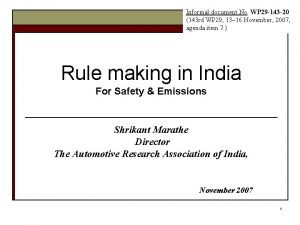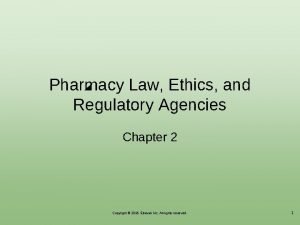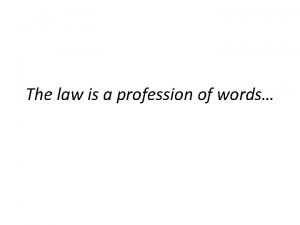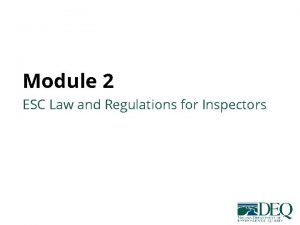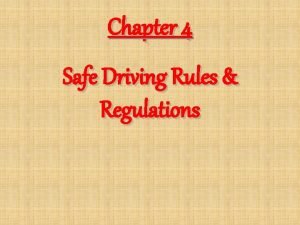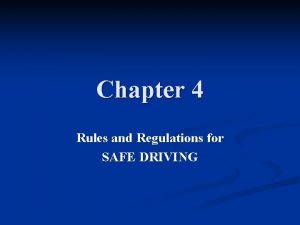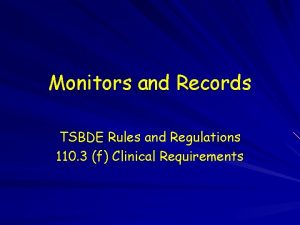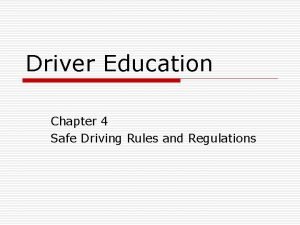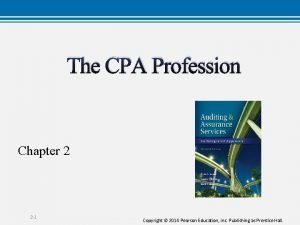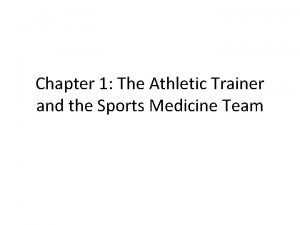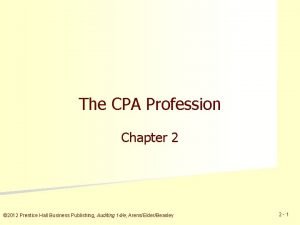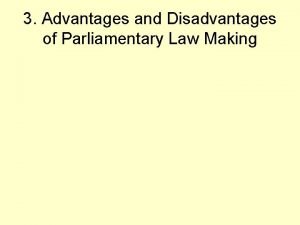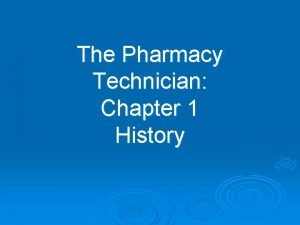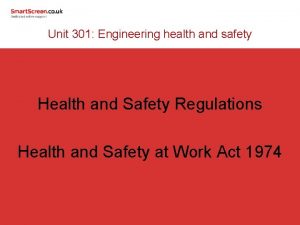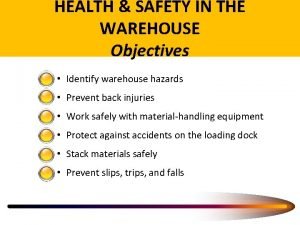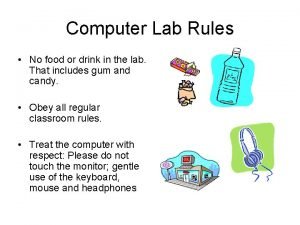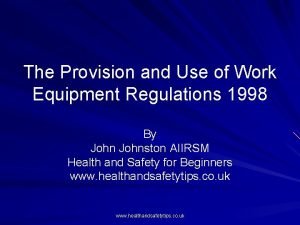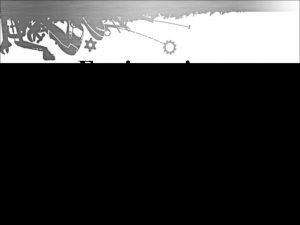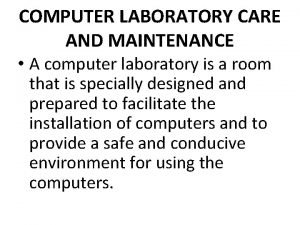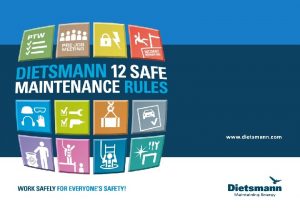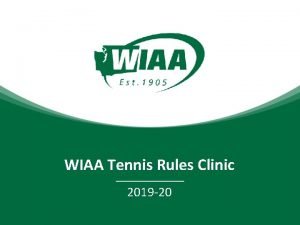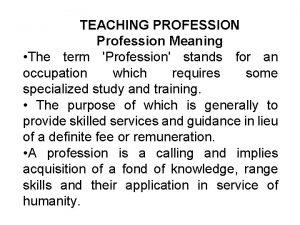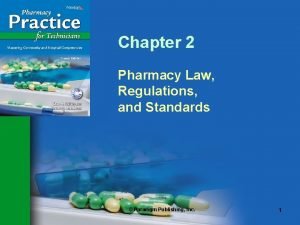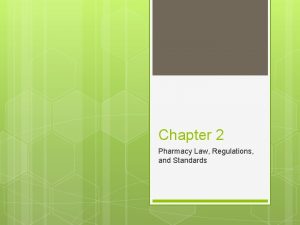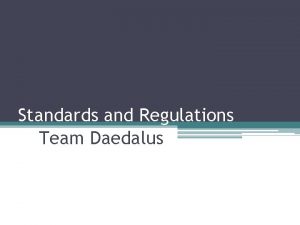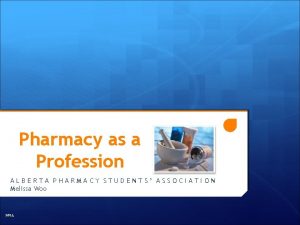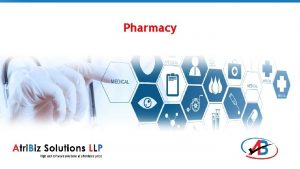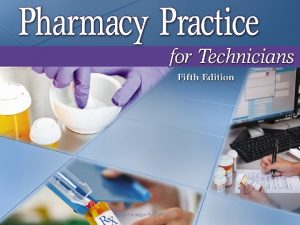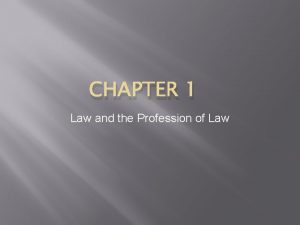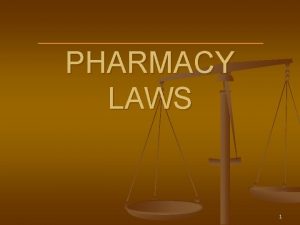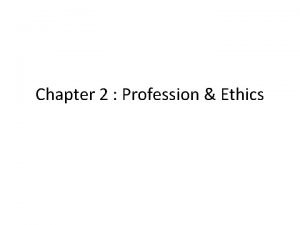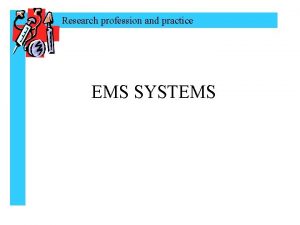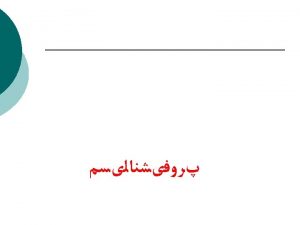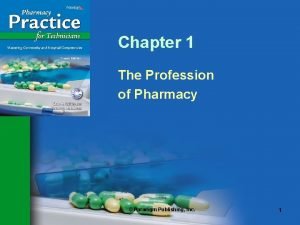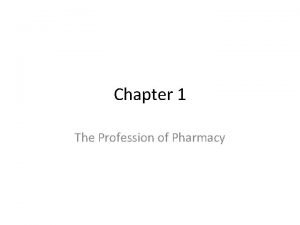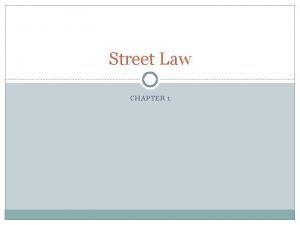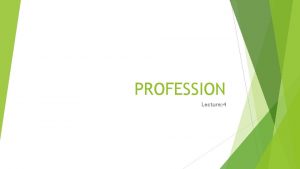Chapter 1 Pharmacy Profession Law Regulations and Standards
















































- Slides: 48

Chapter 1: Pharmacy Profession, Law, Regulations, and Standards

Objectives In this chapter, you will read about: • Outline the origins of pharmacy • Differentiate between the various kinds of pharmacy practices • Identify the four stages of development of the pharmacy profession in the 20 th century • Summarize the functions of a pharmacist • Discuss the education curriculum for today’s pharmacy student • Explain the licensing requirements for pharmacists • Explain the functions and work environments of the pharmacy technician • Describe laws, regulations, professional standards, and ethics that affect the practice of pharmacy • Outline the major pieces of statutory federal drug law in the 20 th century

Objectives In this chapter, you will read about: • Compare and contrast the roles of the Food and Drug Administration, the Drug Enforcement Administration, the Occupational Safety and Health Administration, and the national and state boards of pharmacy • Review the functions that may legally be performed by pharmacy technicians in most states • Discuss the potential for tort actions under the common law related to negligence and other forms of malpractice • Understand the importance of drug and professional standards

Chapter Overview Over the years, the practice of pharmacy has evolved into a scientific and knowledge-based profession. The role of the pharmacist has expanded from one who compounds and dispenses medications to one who also provides information and patient counseling regarding the safe use of these medications.

Pharmacy in Early Civilization • Clay tablets found in 18 th century B. C. E. identified drugs or medicinal preparations from natural sources • Pharmacy comes from the Greek word pharmako • Galen is considered to be the “Father of Pharmacy • The De Materia Medica was the standard for pharmaceutical knowledge until the 16 th century

Pharmacy in the Middle Ages • Throughout Europe during the Middle Ages and Renaissance, physicians prescribed medications or herbal remedies to their patients, which were filled at apothecary shops • The Nuovo Receptario was the first official pharmacopeia

Pharmacy in the Modern Era • During the 17 th and 18 th centuries, a more scientific approach to medicine emerged. • During the 20 th century, many new categories of medicine such as antiseptics, antimicrobials, and antibiotics, including penicillin, were discovered. • Pharmacology has evolved into a science based on systematic research to determine the effects that drugs have on the body.

Evolution of the Pharmacy Profession in the 20 th Century • Traditional era—During this era, the pharmacy profession focused on preparing, compounding, and dispensing drugs from natural sources such as plants.

Evolution of the Pharmacy Profession in the 20 th Century • Scientific era—During this era, the pharmacy profession focused on the development and testing of drugs and their effects on the human body.

Evolution of the Pharmacy Profession in the 20 th Century • Clinical era—During this era, the pharmacy profession focused not only on the traditional roles of compounding and dispensing, but also provided drug information to patients and physicians.

Evolution of the Pharmacy Profession in the 20 th Century • Pharmaceutical care era—This era expanded the role of the pharmacist to include responsibility for appropriate medication use.

Pharmacy Practice Settings The profession of pharmacy ensures the safe and effective use of medication. Pharmacists and pharmacy technicians can be employed in many different settings including retail pharmacies (drug stores) and institutional pharmacies such as hospital pharmacies and pharmacies in assisted-living and long-term–care facilities, pharmaceutical manufacturing, insurance companies and health plans. Pharmacy technicians are employed in most of the same settings as pharmacists.

Retail Pharmacies • A retail pharmacy, also called a community pharmacy or drug store, is usually divided into two areas.

Retail Pharmacies Chain pharmacies Home infusion pharmacies Independent pharmacies Mail-order pharmacies Compounding pharmacies Franchise pharmacies

Institutional Pharmacies • An institutional pharmacy can broadly be defined as a facility that provides pharmaceutical-care services to patients in an institutional facility or organized healthcare system.

Hospital Pharmacies • A hospital pharmacy is an institutional pharmacy that provides services to patients and healthcare professionals in the hospital.

Long-Term–Care Facilities • A long-termcare facility provides a broad range of services for patients requiring a longer length of stay. • These facilities may include nursing homes or assisted-living facilities.

Managed-Care Organizations • A managed-care organization is an organization that controls the financing and delivery of healthcare services for those who are involved in a specific healthcare plan.

Managed-Care Organizations • Health-maintenance organization (HMO) plan

Managed-Care Organizations • Preferred provider organization (PPO) plan • Health-maintenance organization (HMO) plan • Point-of-service (POS) plan

Nuclear Pharmacies A nuclear pharmacy is a specialty practice of pharmacy that promotes health through the safe and effective use of radioactive drugs for diagnosis and therapy.

Role of a Pharmacist • • • Obtaining a patient history, including a medical history, prescription and over-thecounter medication usage history, and allergy history. Verifying dosage, strength, and formulation of the medication Counseling patients on the use of prescription and over-the-counter medications Monitoring and screening for drug interactions Monitoring for duplications of therapy Monitoring response to therapy Making recommendations and providing advice regarding usage of over-thecounter medications and devices Advising patients, physicians, and other healthcare professionals on the selection, dosages, interactions, side effects, and adverse reactions of the medications Monitoring the safe usage of controlled substances Vaccinating high-risk adults

The Educational Curriculum of Today’s Pharmacy Student • Pharmacists who are trained in the United States must earn a Pharm. D. degree from an accredited college or school of pharmacy. The Pharm. D. degree has replaced the bachelor of science in pharmacy degree, which is no longer being awarded.

Licensing Requirements for Today’s Pharmacist • A license to practice pharmacy is required in all 50 states • In order to obtain a license to practice pharmacy, one must have a Pharm. D. degree, a passing grade on the NAPLEX, training, and in some states a passing grade on the MPJE.

The Role of a Pharmacy Technician • The primary role of a pharmacy technician, also called a pharmacy tech, is to receive and fill prescriptions.

The Role of a Pharmacy Technician in a Retail Setting • A pharmacy technician must work under the direct supervision of a licensed pharmacist. A pharmacy technician can assist in all activities that do not require the professional judgment of a pharmacist. • Without pharmacy technicians, pharmacists would not have enough time to perform the clinical tasks necessary to ensure the safe use of medications. Pharmacy technicians help reduce the risk of preventable and costly medication errors. • The duties of a pharmacy technician will vary depending on the work environment

The Role of a Pharmacy Technician in a Hospital • • • Package and label medications. Fill a 24– 72 hour unit-dose cart. Maintain records and gather information for pharmacist’s use. Check the work of another pharmacy technician in the preparation of medication carts. Prepare IV medications. Deliver medications. Stock medications in the pharmacy and satellite locations. Inspect nursing stations for expired medications. Obtain laboratory results for pharmacists. Fill drug boxes or trays for emergency use. Operate manual or computerized robotic dispensing machines.

The Role of a Pharmacy Technician in a Long-Term–Care Facility Fill and maintain drug boxes or emergency kits. Deliver medications to a nursing home. Prepare unit doses of medications. Conduct inspections in nursing homes to remove expired or recalled medications.

Other Roles of a Pharmacy Technician • • Preparing insurance claim forms Maintaining medication profiles Answering phones Stocking shelves and maintaining inventory Ordering medications Cleaning equipment Pricing prescriptions Operating the pharmacy cash register

Education and Licensing of a Pharmacy Technician There are no nationally standardized training requirements for pharmacy technicians. Some states require a high-school diploma or its equivalent. Other states require licensure or registration of pharmacy technicians with state board of pharmacy. Still others require passing a certification exam.

Education and Licensing of a Pharmacy Technician • There are several professional organizations that offer a nationally recognized certification. – Pharmacy Technician Certification Board (PTCB) – National Healthcareer Association (NHA)

Pharmacy Laws, Regulations, Professional Standards, and Ethics • Pharmacy laws, regulations, and standards have been designed to ensure public safety.

Laws • A law is a rule that represents the minimum level of acceptable standards. Laws are passed and enforced to protect the public.

Laws Constitutional law • Constitutional law is derived from the Constitution and the Bill of Rights. Legislative law • Legislative law is drawn from the U. S. Congress and state legislatures. Administrative law • Administrative law is derived from the president or state governor. Common law • Common law is drawn from the judicial branch of the government.

Laws • Violations of laws can occur at the local, state, or federal level, and the legal action taken as a result will depend upon the law that was violated.

Torts • A tort is defined as causing personal injury intentionally or because of negligence. It is a civil case that one citizen brings against another.

Regulations A regulation is a written rule or established guideline that exists to carry out a federal or state law. Regulatory bodies assist in the administration and enforcement of laws. Med. Watch is a system utilized by the FDA to receive information about adverse events or product problems.

Professional Standards • A professional standard is a code of conduct or practice that professionals in a discipline would follow or carry out in a given circumstance.

Ethics • Ethics are a system of moral standards of conduct and behavior for a person, group, or a profession.

History of United States Federal Pharmacy Law • Federal laws set the standards for the practice of pharmacy. These laws were established to protect the public from the unregulated manufacturing, distribution, and dispensing of unsafe drugs.

History of United States Federal Pharmacy Law 1906 • Pure Food and Drug Act 1938 • Food, Drug, and Cosmetic Act 1951 • Durham-Humphrey Amendment 1963 • Kefauver-Harris Amendment 1970 • Comprehensive Drug Abuse Prevention and Control Act 1970 • Poison Prevention Packaging Act (PPPA) 1972 • Drug Listing Act

History of United States Federal Pharmacy Law 1983 • Orphan Drug Act 1984 • Waxman-Hatch Act 1987 • Prescription Drug Marketing Act (PDMA)

History of United States Federal Pharmacy Law 1990 • Anabolic Steroid Control Act 1990 • Omnibus Budget Reconciliation Act (OBRA) 1996 • Health Insurance Portability and Accountability Act (HIPAA) 1997 • Food and Drug Administration Modernization Act

History of United States Federal Pharmacy Law 2003 • Medicare Prescription Drug, Improvement, and Modernization Act 2005 • Combat Methamphetamine Epidemic Act

Regulatory Agencies • Food and Drug Administration (FDA) • Drug Enforcement Administration (DEA) • Occupational Safety and Health Administration (OSHA) • National Association of the Boards of Pharmacy • State Boards of Pharmacy

Drug and Professional Standards • Laws and regulations from local, state, and federal agencies govern the practice of pharmacy. In addition to these laws, national standards for drugs and professional guidelines for behavior and performance have been established by professional organizations.

United States Pharmacopeia • The mission of the USP is to set standards and create programs that improve the health of people around the world by ensuring quality, safety, and benefits of medicines and food.

Professional Organizations APh. A ASHP ASCP • The American Pharmacists Association • The American Society of Health. System Pharmacists • The American Society of Consultant Pharmacists
 Automotive regulations and standards
Automotive regulations and standards Food safety regulations and standards
Food safety regulations and standards Newton's first law and second law and third law
Newton's first law and second law and third law Newton's first law and second law and third law
Newton's first law and second law and third law Chapter 2 pharmacy law ethics and regulatory agencies
Chapter 2 pharmacy law ethics and regulatory agencies Law is a profession of words
Law is a profession of words Esc law regulations
Esc law regulations Boyles law
Boyles law Charles law constant
Charles law constant If a motorist's vehicle becomes disabled he/she must
If a motorist's vehicle becomes disabled he/she must Chapter 4 safe driving rules and regulations
Chapter 4 safe driving rules and regulations Chapter 4 safe driving rules and regulations
Chapter 4 safe driving rules and regulations Head tilt chin lift and jaw thrust maneuver is used for
Head tilt chin lift and jaw thrust maneuver is used for Controlled uncontrolled and blind intersections
Controlled uncontrolled and blind intersections Customer service standards table
Customer service standards table The cpa profession chapter 2
The cpa profession chapter 2 The cpa profession chapter 2
The cpa profession chapter 2 Vimeforum
Vimeforum Chapter 1 athletic training as a profession
Chapter 1 athletic training as a profession Social work: an empowering profession 9th edition chapter 1
Social work: an empowering profession 9th edition chapter 1 Chapter 1 athletic training as a profession
Chapter 1 athletic training as a profession Chapter 1 introduction to the dental profession
Chapter 1 introduction to the dental profession The cpa profession chapter 2
The cpa profession chapter 2 Advantages of acts of parliament
Advantages of acts of parliament Applications of molality in pharmacy
Applications of molality in pharmacy Which profession do you like
Which profession do you like Teaching as a vocation
Teaching as a vocation Panggilan karya atau profesi adalah
Panggilan karya atau profesi adalah Code of ethics for professional teachers section 7
Code of ethics for professional teachers section 7 Issues and ethics in the helping profession
Issues and ethics in the helping profession History of pharmacy technicians
History of pharmacy technicians Health and safety regulations in engineering
Health and safety regulations in engineering Food safety standards
Food safety standards Six pack health and safety regulations
Six pack health and safety regulations Rules and regulations of table tennis
Rules and regulations of table tennis Class rules and regulations
Class rules and regulations Loading dock safety
Loading dock safety No food or drink near computers
No food or drink near computers Child care facility rules and regulations
Child care facility rules and regulations Why do we have hunting laws and regulations
Why do we have hunting laws and regulations Provision and use of work equipment regulations
Provision and use of work equipment regulations H&s six pack
H&s six pack Computer laboratory rules and regulations
Computer laboratory rules and regulations Bwca rules and regulations
Bwca rules and regulations Dietsmann wikipedia
Dietsmann wikipedia Wiaa rules clinic
Wiaa rules clinic Bangladesh payment and settlement systems regulations 2014
Bangladesh payment and settlement systems regulations 2014 Work health and safety regulations 2012 sa
Work health and safety regulations 2012 sa Legal regulations compliance and investigation
Legal regulations compliance and investigation
